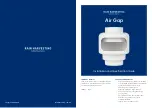
Section 4: Operating Procedures
1/13/21
24
Basic Operating Instructions
1.
Dig Safe, Call 811.
Contact your local utility
companies (electrical, telephone, gas, water, sewer,
and others) before digging so that they may mark the
location of any underground services in the area.
2. Thoroughly inspect work area for sprinkler heads,
and any other unforeseen objects that may be a
hazard. Remove all potential hazards and mark any
that cannot be removed.
3. Place grade stakes if you intend to develop a specific
grade or soil level.
4. Adjust blade to the desired angle, tilt, and offset
position before lowering blade to the ground.
5. Lower blade to the ground and proceed forward at a
speed of no more than 2 to 4 mph. The blade should
immediately begin shaving the soil surface.
6. Set tractor’s draft-link height control lever to the
desired grade position. If blade is set at a 90 degree
angle to the direction of travel, it may be necessary to
raise the blade slightly so that dirt and gravel can flow
out evenly under the blade as it shaves off high spots
and fills in potholes or depressions.
General Operating Instructions
Once you have familiarized yourself with the Operator’s
Manual, completed the operations checklist, and
properly attached your Land Pride Rear Blade to your
tractor, you are now almost ready to begin work. The
RBT45 Series Rear Blades were designed and built by
Land Pride for category lI and lII three-point hitch and
Quick Hitch attachment for 75 to 125 hp tractors
equipped with remote hydraulic outlets and two wheel
drive capability. They are ideal for snow removal as well
as dirt leveling, finish grading, and backfilling
applications at feedlots, outdoor arenas, building, and
construction sites, and maintenance operations on farm
and ranch lanes or roadways. They are also excellent for
soil contouring and construction and maintenance of
ditches and waterways.
Hopefully you have checked out your work site for any
buried utility cables, pipelines, sprinkler heads, or other
obstacles that you wouldn’t want to damage or
encounter. Grade stakes should now be in place if you
intend to develop a specific grade, elevation, soil contour,
or roadbed crown. A RBT45 Series Rear Blade’s primary
purpose is for grading or leveling of soil, gravel, or
aggregate in the warmer months or snow removal in the
colder months. These functions are best done at an
approximate 2 to 4mph ground speed. Becoming
proficient with a Rear Blade takes practice.
Tractor horsepower, your personal skill level, soil or
aggregate composition, moisture levels, and compaction
factors will all have a definite impact on how easily and
effectively you get the job done when you are in the dirt
working mode. Develop a plan to achieve your expected
results. Set the blade up at the proper angle or angles to
do the job. The hydraulic angling, tilt, and offset
capabilities of the RBT45 series will make these
adjustments easy utilizing the tractors remote hydraulic
controls. This may require some experimentation to
achieve the desired results. Lower the blade to the
ground and proceed forward at a speed of no more than
2 to 4 mph. The blade should immediately begin shaving
the soil surface and dirt or aggregate material. Set the
tractor’s draft-link height control in the desired position.
With the blade set at a 90 degree angle you may need to
raise the blade slightly so that the dirt or gravel can flow
out evenly under the blade effectively shaving off high
spots and filling in potholes or depressions.
If you have the blade set at a horizontal angle, the shaved
or accumulated material will begin to move outward
toward the trailing edge of the blade. The greater the
angle the more quickly the shaved material will be
distributed off to the side. If it is necessary to work up next
to a building foundation, abutment, or raised curb you
may want to offset the blade so that the outside edge of
the blade is beyond the outer edge of the tractor tire in
working position. Back-filling operations may be more
easily performed by reversing the blade and operating
the tractor in reverse or commonly called the push mode.
Be careful not to over-stress the rear blade while
backfilling as load forces on the blade and frame
increase while backing up.
If you are performing the construction of soil contours or
waterways you will probably need to set a tilt angle on the
blade to achieve the desired effect. If you are grading or
cutting a new ditch bank or forming a road crown, you will
probably want to offset the blade in combination with
setting an appropriate tilt angle. This again will likely
require some experimentation to gain desired results.
Snow removal techniques with a blade will be very similar
to dirt working techniques and will require a little
experimentation to become proficient.
With a little practice you should become a very good
operator and consistently achieve the desired results you
expect with your Land Pride RBT45 Series Rear Blade.
See
“Specifications” & “Capacities”
on page 28 and
“
Features and Benefits
” on page 29 for additional
information and performance enhancing options.











































